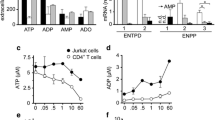Abstract
Leflunomide is an anti-inflammatory and immunosuppressive agent which blocks proliferation of transformed cells and mitogen stimulated normal lymphocytes but does not block T cell signalling mechanisms at antiproliferative concentrations. These properties are consistent with a mechanism involving interference with nucleotide metabolism. Leflunomide had anti-proliferative activity against all cells tested here. The anti-proliferative activities could be reversed by addition of uridine or cytidine to the cultures although some species and cellular differences were observed. Purine nucleosides had no effect. Measurements of nucleotide pools in a human T cell line and mitogen stimulated rat spleen cells treated with leflunomide showed that leflunomide preferentially reduces pyrimidine nucleotide levels. These results indicate that inhibition of pyrimidine biosynthesis is responsible for the anti-proliferative effects of leflunomide.
Similar content being viewed by others
References
Bartlett RR, Dimitrijevic M, Mattar T, Zielinski T, Germann T, Rude E, et al. Leflunomide (HWA 486), a novel immunomodulating compound for the treatment of autoimmune disorders and reactions leading to transplantation rejection. Agents Actions 1991;32:10–21.
Zielinski T, Herrmann M, Muller HJ, Riedel N, Bartlett RR. The influence of leflunomide on cell cycle, IL-2-receptor (IL-2-r) and its gene expression. Agents Actions 1994;41:205.
Ulrichs K, Kaitschick J, Bartlett R, Muller Ruchholtz W. Suppression of natural xenophile antibodies with the novel immunomodulating drug leflunomide. Transplant Proc 1992;24:718–9.
Williams JW, Xiao F, Foster PF, Chong A, Sharma S, Bartlett R, et al. Immunosuppressive effects of leflunomide in a cardiac allograft model. Transplant Proc 1993;25:745–6.
Schorlemmer HU, Weiler FR, Bartlett RR. Prolongation of allogeneic transplanted skin grafts and induction of tolerance by leflunomide, a new immunosuppressive isoxazole derivative. Transplant Proc 1993;25:763–7.
Glant TT, Mikecz K, Bartlett RR, Deak F, Thonar EJMA, Williams JM, et al. Immunomodulation of proteoglycaninduced progressive polyarthritis by leflunomide. Immunopharm 1992;23:105–16.
Coupland SE, Klebe S, Karow AC, Krause L, Kruse H, Bartlett RR, et al. Leflunomide therapy following penetrating keratoplasty in the rat. Graefes Archive for Clinical & Exp Ophthalmol 1994;232:622–7.
Niederkorn JY, Lang LS, Ross J, Mellon J, Robertson SM. Promotion of corneal allograft survival with leflunomide. Invest Ophthalmol & Visual Science 1994;35:3783–5.
Schorlemmer HU, Bartlett RR. Therapeutic activity of leflunomide in acute and chronic relapsing experimental allergic encephalomyelitis. Agents Actions 1994;41:273.
Robertson SM, Lang LS. The efficacy of leflunomide in s-antigen-induced autoimmune uveitis. Agents Actions 1994;41:275.
Domlian Z, Popovic M, Mladenovic V, Rozman B, Mihalovic D, Jajic I, et al. Efficacy and safety of leflunomide in the treatment of patients with rheumatoid arthritis. Arthritis Rheum 1993;36:S56.
Weithmann KU, Jeske S, Schlotte V. Effect of leflunomide on constitutive and inducible pathways of cellular eicosanoid generation. Agents Actions 1994;41:164–70.
Chong AS-F, Finnegan A, Jiang X, Gebel H, Sankary HN, Foster P, et al. Leflunomide, a novel immunosuppressive agent. The mechanism of inhibition of T cell proliferation. Transplantation 1993;55:1361–6.
Cherwinski HM, McCarley D, Schatzman R, Devens B, Ransom JT. The immunosuppressant leflunomide inhibits lymphocyte progression through cell cycle by a novel mechanism. J Pharm Exp Ther 1995;272:460–8.
Nikcevich DA, Finnegan A, Chong A, Williams JW, Bremer EG. Inhibition of interleukin 2 (IL-2)-stimulated tyrosine kinase activity by leflunomide. Agents Actions 1994;41:282.
Mattar T, Kochhar K, Bartlett R, Bremer EG, Finnegan A. Inhibition of the epidermal growth factor receptor tyrosine kinase activity by leflunomid. FEBS Lett 1993;334:161–4.
Price DJ, Grove JR, Calvo V, Avruch J, Bierer BE. Rapamycin-induced inhibition of the 70-kilodalton S6 protein kinase. Science 1992;257:973–7.
Jaffee BD, Jones EA, Loveless SE, Chen SF. The unique immunosuppressive activity of brequinar sodium. Transplant Proc 1993;25:19–22.
Allison AC, Kowalski WJ, Muller CJ, Eugui EM. Mechanisms of action of mycophenolic acid. Annals of the New York Academy of Sciences 1993;696:63–87.
Shimonkevitz RJ, Kappler J, Marrack P, Grey H. Antigen recognition by H-2 restricted T Cells. I. Cell-free antigen processing. J Exp Med 1983;158:303.
Ransom JT, Cherwinski HM, Delmendo RE, Sharif NA, Eglen R. Characterization of the m4 muscarinic receptor Ca2+ response in a subclone of PC12 cells by single cell flow cytometry. Inhibition of the response by bradykinin. J Biol Chem 1991;266:11738–45.
Mosmann TR. Rapid colorimetric assay for cellular growth and survival: application to proliferation and cytotoxicity assays. J Immunol Meth 1983;65:55–63.
Chong AS-F, Gebel H, Finnegan A, Petraitis EE, Jiang XL, Sankary HN, et al. Leflunomide, a novel immunomodulatory agent: In vitro analyses of the mechanism of immunosuppression. Transplant Proc 1993;25:747–9.
Chen SF, Papp LM, Ardecky RJ, Rao GV, Hesson DP, Forbes M, et al. Structure-activity relationship of quinoline carboxylic acids. A new class of inhibitors of dihydroorotate dehydrogenase. Biochem Pharm 1990;40:709–14.
Eugui EM, Almquist SJ, Muller CD, Allison AC. Lymphocyte selective cytostatic and immunosuppressive effects of mycophenolic acid in vitro: Role of deoxyguanosine nucleotide depletion. Scand J Immunol 1991;33:161–73.
Author information
Authors and Affiliations
Rights and permissions
About this article
Cite this article
Cherwinski, H.M., Byars, N., Ballaron, S.J. et al. Leflunomide interferes with pyrimidine nucleotide biosynthesis. Inflamm Res 44, 317–322 (1995). https://doi.org/10.1007/BF01796261
Received:
Revised:
Accepted:
Issue Date:
DOI: https://doi.org/10.1007/BF01796261




